Most people will go their entire lives without ever seeing a pink mushroom. And what a shame that is, as they are nothing short of stunning!
Pink Oyster (Pleurotus djamor), also known as the Flamingo oyster, is a tropical oyster mushroom that likes it warm and damp. In the wild, it is found on tropical hardwood trees in Mexico, Indonesia, and other places with comparable conditions.
Fortunately, it can be easily cultivated, ideally during the warm summer months. However, it may also be grown all year round indoors under lights or in a tropical greenhouse. It can be grown on straw, hardwood, cardboard, paper, mulch, and coffee grounds, and it is one of the fastest-growing edible mushrooms, as it takes only about two weeks to grow.
I grew this beauty „myself“ from a mushroom grow kit that can easily be acquired online. The mushroom grow kit has a fully colonized substrate and only needs exposure to the sun, fresh air, and humidity. Vibrant pink clusters will form on the surface of the substrate and develop into beautiful pink mushrooms. One can also go the longer route, prepare the mushroom substrate and start the mushrooms from mushroom spawn, which requires more knowledge and time, as the mycelium needs to fully colonize the substrate before the fruiting bodies (mushrooms) appear.
I was deeply moved and captivated by watching these beauties grow. They grew so fast and each day there was an elaborate photo-shooting to capture their complex textures and multi-layered structure.
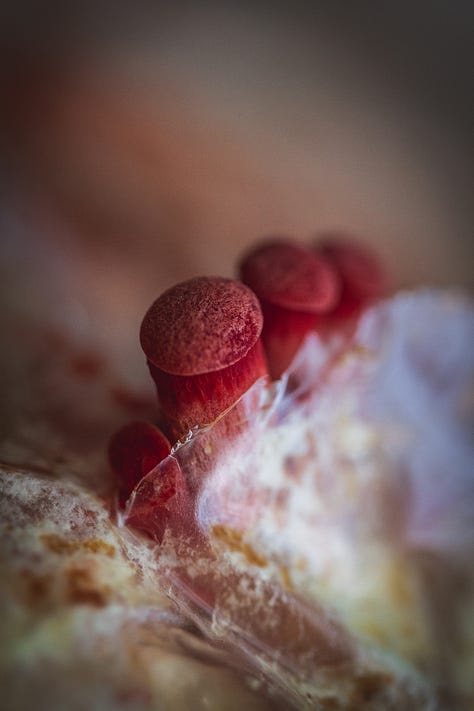

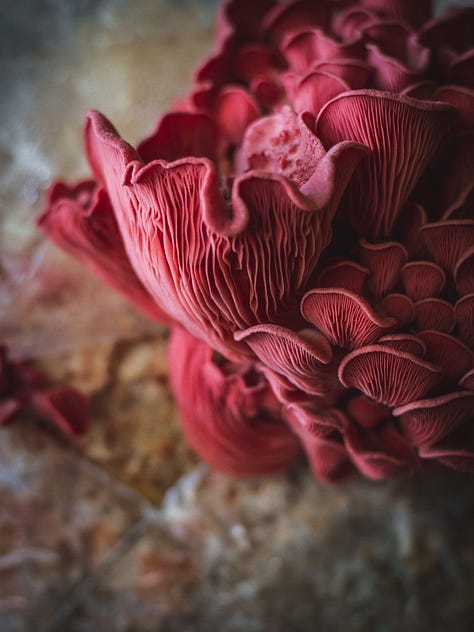
These mushrooms should be collected when they are still small because as they grow, their color fades and the change in the aroma is making them less appetizing. Cutting the fruits off the substrate with a sharp knife is all that is required to harvest the mushrooms when they are ready. As pink oysters are prolific fruiters, a second or third harvest can be easily obtained.
Freshly picked pink oysters will keep fresh for a few days in the refrigerator. Alternatively, you can freeze them to extend their shelf life. As our three crops were quite large, I dried all that we couldn’t eat in a few days. They last up to six months if stored in an airtight container in a cool and dark place. Once dried, they can easily be ground and added to salt, to get a beautiful pink salt that adds a special umami flavor to numerous dishes.
Pink oysters, like all mushrooms, are an excellent source of protein, fiber, vitamins, minerals, and antioxidants, boosting the immune system and protecting cells from free radical damage. The results of a study indicate that pink oyster “administration significantly stimulates neutrophil adherence, phagocytosis, and killing ability. Neutrophils are a vital component of the host defense strategy.”
They are full of heart-supporting nutrients, like ergothioneine, an antioxidant reducing cholesterol levels, preventing plaque build-up in arteries, and cardiovascular disease. They are also significant for the prevention of hyperlipidemia and are great for digestion and gut health. A test-tube study conducted with oyster mushrooms showed that they helped reduce the secretion of inflammation markers throughout the body.
Pink oyster mushrooms have a subtly sweet apricot scent and taste slightly bitter when raw, but can be eaten raw, as they’re non-toxic. They have a seafood-like succulent texture, similar to lobster or crabmeat, and taste slightly sweet and nutty when cooked. Their taste intensifies when cooked longer (about twenty minutes) or till crispy and reminds some of bacon or ham. The meat- and seafood-like flavor makes them a wonderful meat substitute in many dishes. Their deep pink color changes to an orange-brown hue when cooked and gives dishes an immense range of flavor and depth – they elevate any dish and give them that special rich umami complexity.
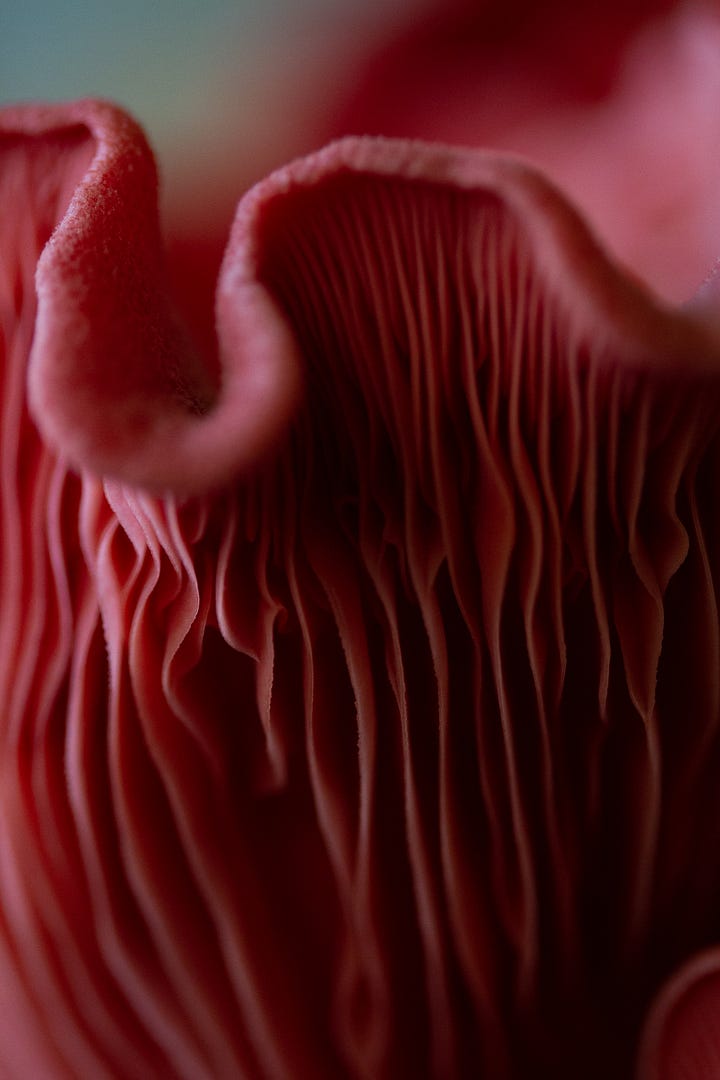
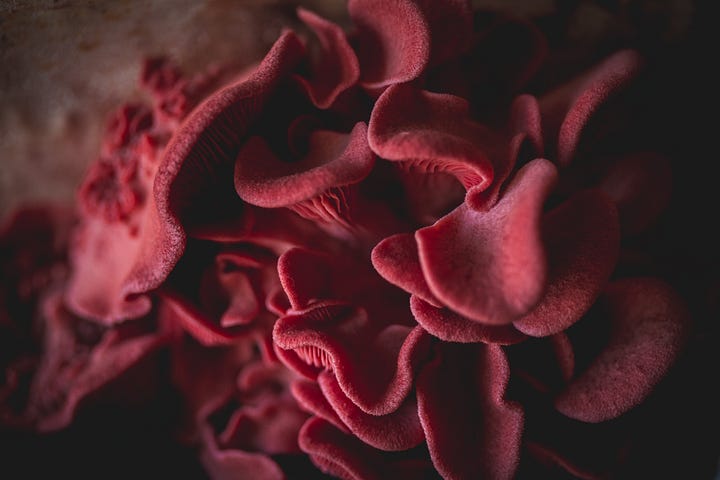
SOME DELICIOUS RECIPE IDEAS
These mushrooms with vibrant pink color are often used in salads, soups, stir-fries, and stews. They can be cooked, grilled, roasted, or sautéed and add a touch of elegance to any meal. They pair well with garlic, ginger, onion, green onions, coriander, parsley, mint, basil, sesame oil, curcumin, soy sauce, bell pepper, red cabbage, broccoli, corn, leeks, quinoa, noodles, rice, potatoes, eggs, and so much more.
Sautéed pink oysters
This is the simplest recipe you can try out to turn your beautiful pink oysters into a delicious meal. While it is disappointing that they don’t retain their coral pink hue, they turn bright golden and add a sunny touch to your dish. For best results sauté mushrooms in butter for about 15 minutes in order to deeply caramelize the oysters.
Simplest version: pink oyster, butter, salt & pepper
Add anything your heart desires: garlic, onion, fresh or dried herbs, Parmigiano, fresh or sour cream, eggs
I love adding sautéed pink oysters to a sandwich, like this one with fresh cheese, purple basil, fresh thyme, sliced radish, grated fresh horseradish, and coarse salt. A truly royal sandwich.
Pink oyster soba noodle soup
A hearty and healthy soba noodle soup with pink oysters in a simple miso broth for a quick, easy, and delicious meal, ready in under 30 minutes.
Cook your gluten-free 100% buckwheat noodles according to the package, rinse under cool water, and set aside. In a wok or medium pan, sautée pink oyster mushrooms in butter or sesame oil until golden, set aside. Cut tofu into cubes and sautée in the pan until crunchy, set aside. In a medium cooking pan sautée finely cut ginger, green onions, garlic, and leek, and add water or vegetable stock and any other vegetables (for example bok choy, broccoli, or carrots) or algae (for example wakame), cook, on low for about 10-15 minutes. Add miso paste and gently stir to dissolve and don’t let the soup boil. Add salt, pepper, and chili spice to your taste. In individual serving bowls, add noodles, mushrooms, tofu, and miso broth and garnish with fresh herbs, microgreens, and seeds. Again, you can add whatever your heart desires.
Beetroot wontons with pink oysters
For the beetroot wonton wrappers:
200 g bread flour
100 ml freshly pressed juice of raw beetroot
cornstarch (for dusting)
For the pink oyster filling:
150 g finely chopped pink oyster mushrooms
1 tablespoon finely chopped purple basil
1 green onion (thinly sliced)
1 garlic clove (crushed)
1 teaspoon minced ginger
butter or sesame oil
salt, pepper, chili (to your taste)
Put the flour in the mixing bowl and add the freshly pressed juice of the beetroot. Mix vigorously, then knead with your hands until the dough is cohesive. Cover and let rest for up to 4 hours. Meanwhile, heat the oil in a skillet, add onions, garlic, and ginger, and cook until slightly crunchy, add mushrooms until they release their juices and the liquid evaporates completely (about 10 minutes). Stir in fresh herbs and spices, salt. Remove from heat and let cool completely.
After resting, the dough will be much smoother, divide it into quarters and work with one quarter at a time (keep the rest covered). Flatten your piece of dough into a rectangular shape, dust the dough thoroughly with cornstarch on both sides, and roll out through the pasta roller until thin. Cut the thin dough into squares or circles. Dust each side of every wonton with cornstarch again.
It’s best to assemble the wontons immediately. Fill a small bowl with water. On a dry surface, lay the wonton wrappers. Drop about a good half of a tablespoon of the cold mushroom filling in the middle of each wonton, keeping the edges free and clean. Spread a bit of water around the edges and fold the wonton wrapper together on top in the middle. Place the finished wonton on the baking sheet and repeat until you’ve used all the filling.
You can either cook the wontons in boiling water for 5-6 minutes or spray them with oil and bake them for 8-10 minutes until lightly browned and crisp. Serve the wontons with a sauce of your choice or in a soup.
If you have any wontons left, you can also freeze them within 1 hour of assembly. Put them in the freezer on a parchment-lined baking tray, so they’re not touching and they freeze individually. Freeze overnight until solid, then transfer to freezer bags and store for up to 3 months.
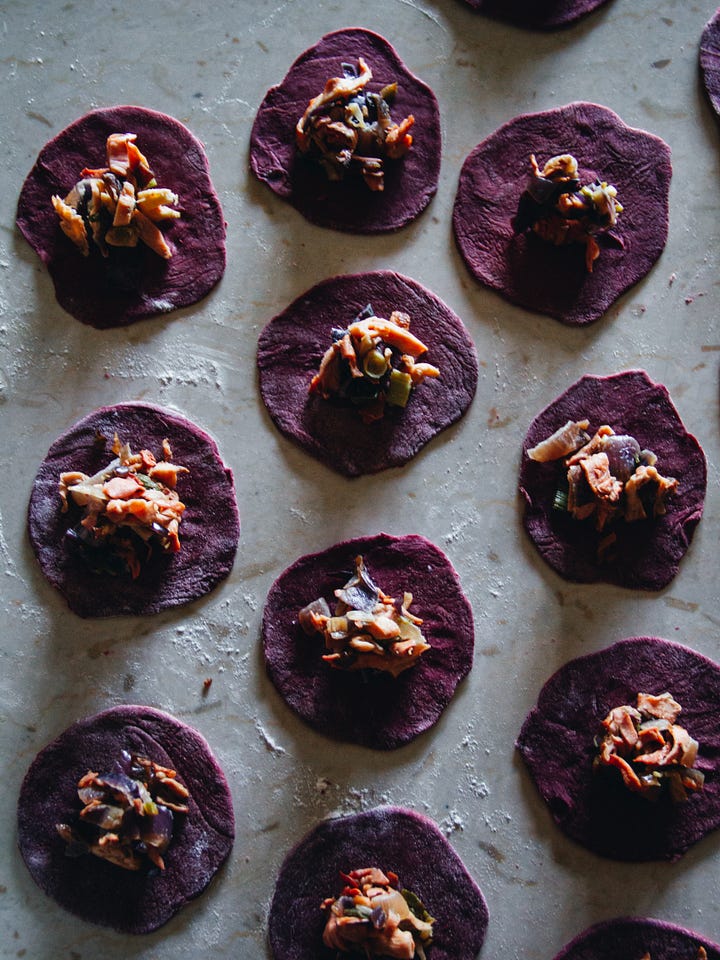
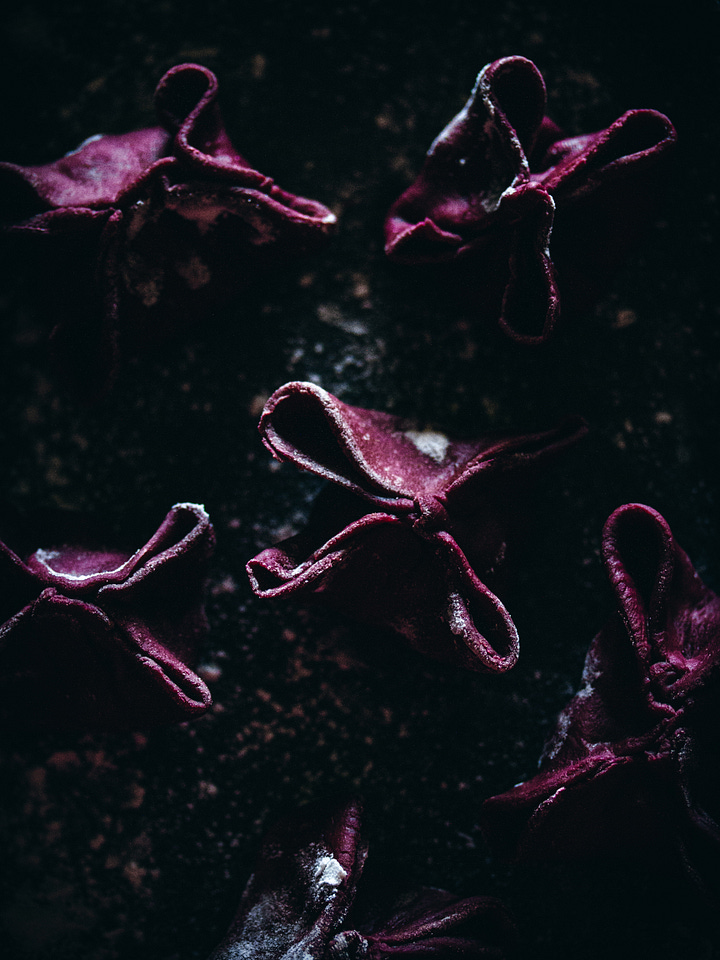




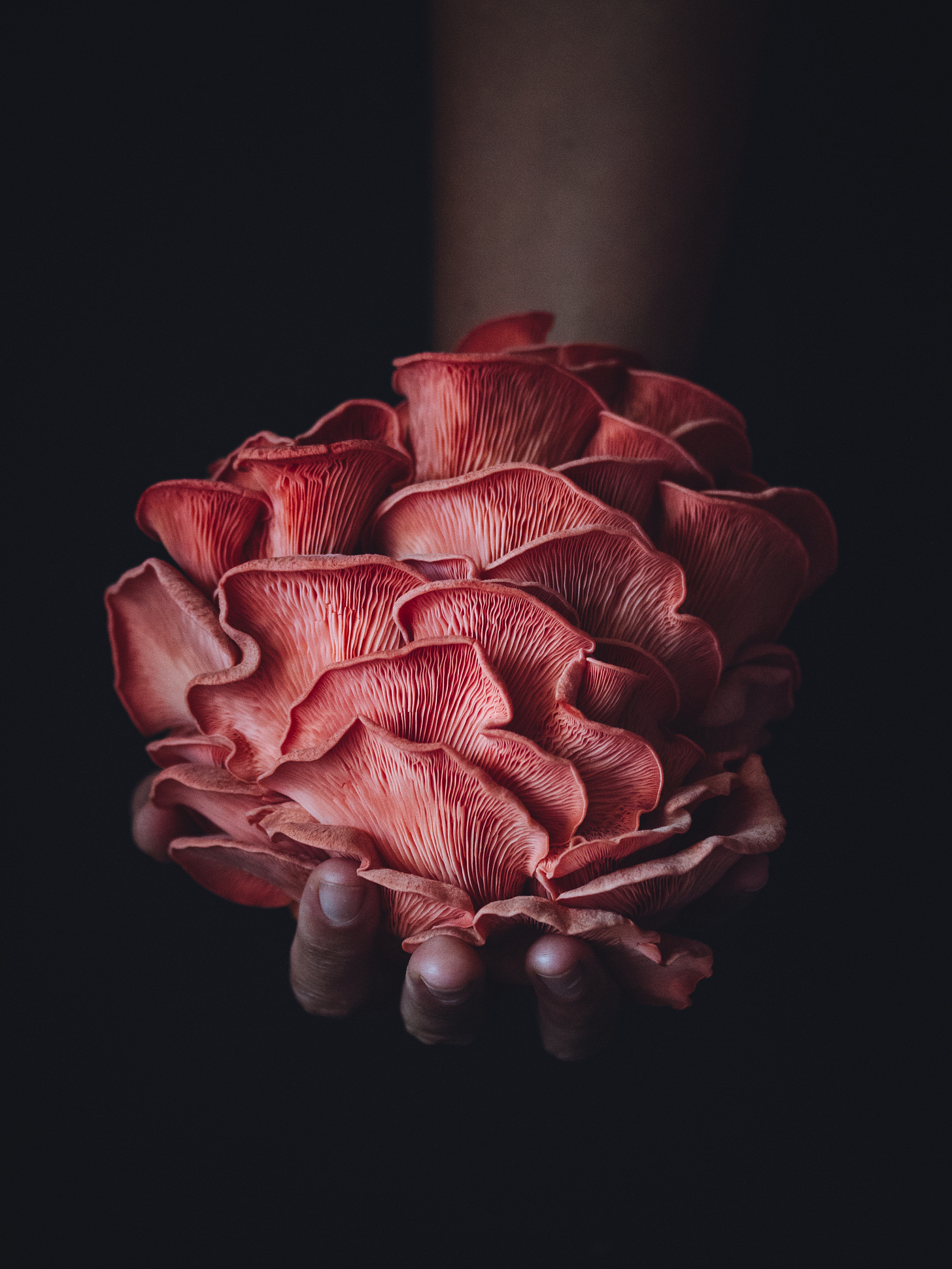



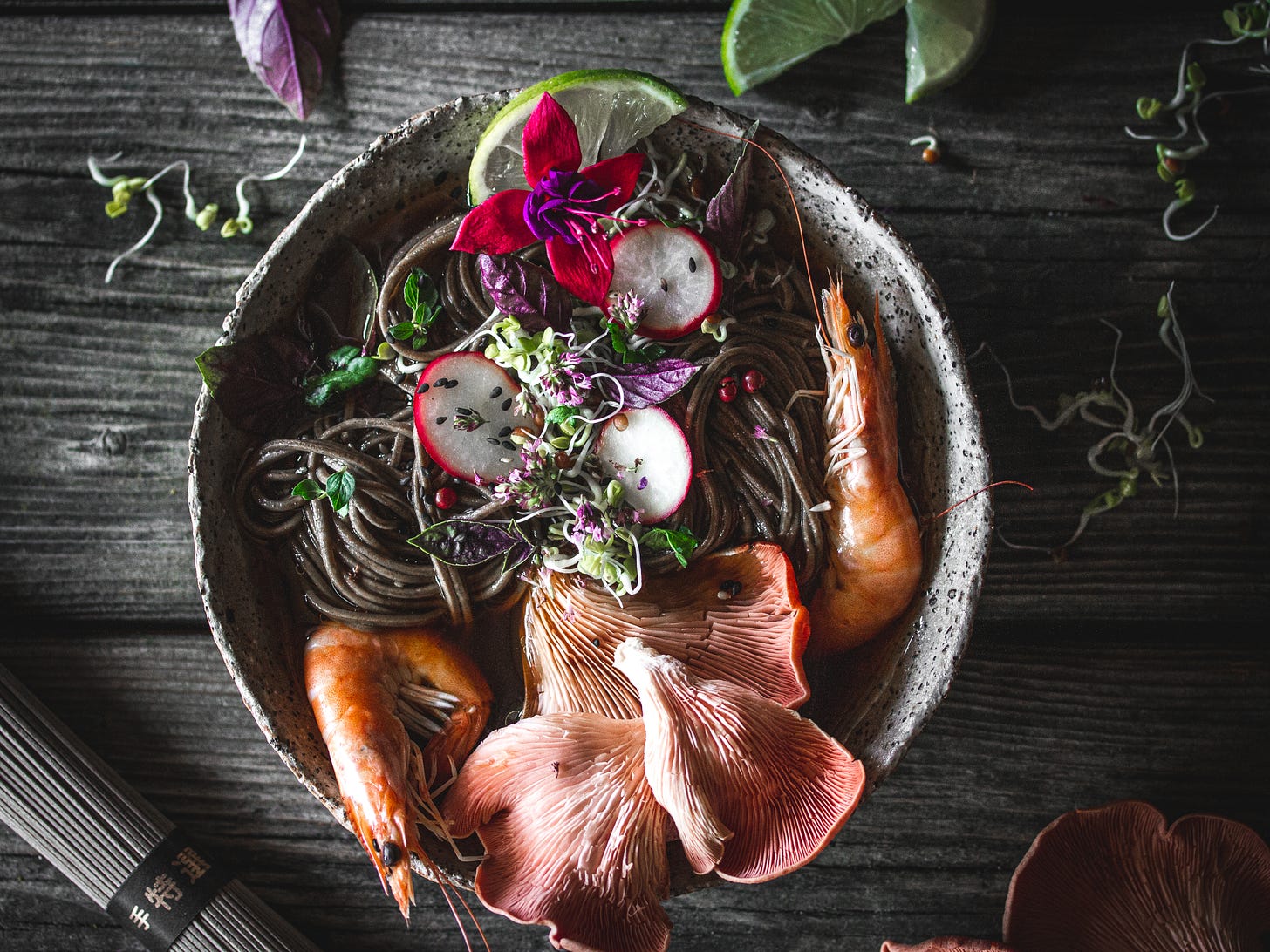
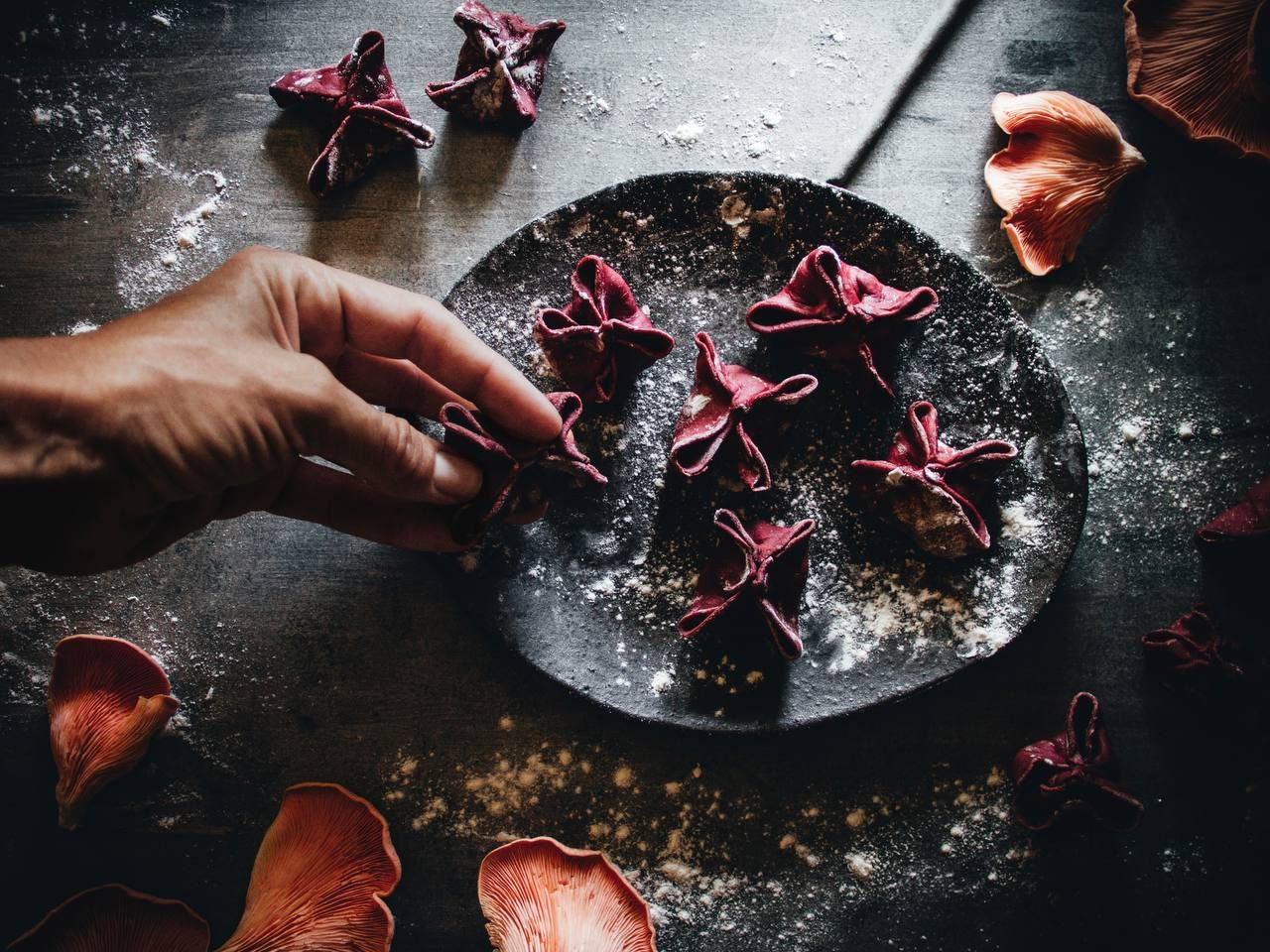
So incredibly beautiful! Reminds me of the ocean - as though it is bringing wisdom from the depths of the sea, to the land, sparking a conversation among the ecology about the truth of beauty of both places.